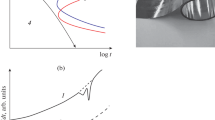Abstract
The thermobaric and concentrational stresses, which arise during the operation of a membrane element under cyclic conditions, can result in the violation of the integrity of a membrane comprising an element and in failure of the element. Studies of the effect of thermobaric cycling in a hydrogen atmosphere at operating parameters (pressure differential, temperature, time of operation) on the properties of membranes allow us to determine the optimum operation conditions of the membrane element. The stability of the Pd–6 wt % In–0.5 wt % Ru–1 wt % Co membrane structure is estimated using the studied temperature dependence of the specific hydrogen permeability of the membrane during its operation in a hydrogen atmosphere, and the possibility of efficient operation of the membrane under given conditions in a temperature range of 250–600°C is noted. The surface of the Pd–6 wt % In–0.5 wt % Ru–1 wt % Co membrane subjected to thermobaric cycling in a commercial-purity hydrogen atmosphere is studied by atomic force microscopy and X‑ray diffraction analysis.






Similar content being viewed by others
REFERENCES
A. G. Knapton, “Palladium alloys for hydrogen diffusion membranes,” Platinum Met. Rev. 21, 44–50 (1977).
S. Yun and T. Oyama, “Correlation in palladium membranes for hydrogen separation,” J. Membrane Sci. 375, 28–45 (2011).
H. Hamilton, “PGM highlights: palladium-based membranes for hydrogen separation,” Platinum Met. Rev. 56 (2), 117–123 (2012).
N. A. Al-Mufachi, N. V. Rees, and R. Steinberger-Wilkens, “Hydrogen selective membranes: a review of palladium-based dense metal membranes,” Ren. Sust. Energy Rev. 47, 540–551 (2015).
V. A. Goltsov, P. V. Geld, E. G. Kagan, N. I. Timofeev, I. F. Belyaev, V. A. Mitjushov, and S. K. Kurumchina, “Alloy on the basis of palladium for the manufacture of filtering elements used in preparation of hydrogen of super-high purity,” US Patent 3804616, 1974.
G. S. Burkhanov, N. B. Gorina, N. B. Kolchugina, and N. R. Roshan, “Palladium alloys for hydrogen engineering,” Zh. Ross. Khim. Obshchestva 1, 36–40 (2006).
V. M. Ievlev, A. I. Dontsov, N. B. Morozova, N. R. Roshan, O. V. Serbin, A. S. Prizhimov and K. A. Solntsev, “Techniques for surface cleaning of membrane foil from palladium-based solid solutions,” Inorg. Mater. 56 (10), 1059–1064 (2020).
G. S. Burkhanov, N. B. Kolchugina, N. R. Roshan, D. I. Slovetskii, and E. M. Chistov “Palladium-based alloy membranes for separation of high purity hydrogen from hydrogencontain gas mixture,” Platinum Met. Rev. 55 (1), 3–12 (2011).
V. M. Avdyukhina, O. V. Akimova, I. S. Levin, and G. P. Revkevich, “Nonmonotonic redistribution of indium atoms in Pd–In–Ru alloy foils after electrolytic hydrogenation,” Russ. Metall. (Metally), No. 7, 646–651 (2011).
N. R. Roshan, S. V. Gorbunov, E. M. Chistov, F. R. Karelin, K. A. Kuterbekov, K. Zh. Bekmyrza, and E. T. Abseitov, “Palladium alloy membranes for the preparation of high-purity hydrogen,” Perspek. Mater., No. 6, 47–57 (2020).
D. Yu Pushcharovskii, X-ray Analysis of Minerals (ZAO Geoinformmark, Moscow, 2000), pp. 112–116.
ACKNOWLEDGMENTS
We thank T.P. Kaminskaya (Moscow State University, Physical Faculty) for studying the membrane surface by AFM.
Funding
This study was supported by the Ministry of Education and Science of Republic of Kazakhstan in terms of the scientific and technical program Development of Hydrogen Energy Technology in Republic of Kazakhstan, project no. BR05236795.
Author information
Authors and Affiliations
Corresponding authors
Additional information
Translated by N. Kolchugina
Rights and permissions
About this article
Cite this article
Burkhanov, G.S., Roshan, N.R., Gorbunov, S.V. et al. Operational Stability of the Pd–6 wt % In–0.5 wt % Ru–1 wt % Co Membrane during Its Cyclic Operation in Manufacturing High-Purity Hydrogen. Russ. Metall. 2021, 313–319 (2021). https://doi.org/10.1134/S003602952103006X
Received:
Revised:
Accepted:
Published:
Issue Date:
DOI: https://doi.org/10.1134/S003602952103006X



